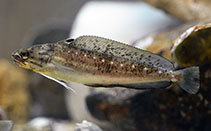| Family: |
Phycidae (Phycid hakes) |
| Max. size: |
43 cm TL (male/unsexed) |
| Environment: |
demersal; marine; depth range 0 - 494 m, non-migratory |
| Distribution: |
Northwest Atlantic: Canada to southern New England to the northeast coast of Florida; also found in the northeastern Gulf of Mexico. |
| Diagnosis: |
Dorsal spines (total): 0-0; Anal spines: 0-0. Upper limb of the first gill arch with 2 or 3 rakers. Head with a series of dark spots; opercle with a dusky blotch. First dorsal fin with a dark blotch and a distinct white margin. |
| Biology: |
Found onshore, most common between 110 and 185 m. Feed on crustaceans, and possibly fish and squids. Juveniles spend part of their time in estuaries. |
| IUCN Red List Status: |
Least Concern (LC); Date assessed: 16 September 2014 Ref. (130435)
|
| Threat to humans: |
harmless |
Source and more info: www.fishbase.org. For personal, classroom, and other internal use only. Not for publication.

